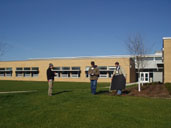The most accurate way of judging sunshade performance is to analyze data compiled over a long time period. Because this case study focused on summer solar heat gains, it would have been necessary to take hourly measurements in the field from June through September. This was impractical since the study period occurred during the winter. Therefore, the performance had to be simulated. In order to simplify this process, the summer solstice, usually June 21, was chosen as the benchmark date for all data and analysis. There are three ways to conduct a simulation:
1. manual calculation - tedious and time consuming
2. sun peg model - useful for sunshades of complex geometry
3. computer simulation - useful for simple shading devices
Since the configuration of the shading devices at Ash Creek are so simple, the computer simulation seemed the best choice.
|
|
 |
|
|



